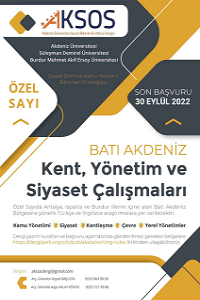AŞK-I MEMNU’DA ERKEĞİN SUNUMU
Toplumsal cinsiyet, erkeklik, Türk dizileri, Aşk-ı Memnu
REPRESENTATION OF MEN IN FORBIDDEN LOVE
Gender, Male, Turkish series, Aşk-ı Memnu,
___
- Akyürek, Feridun (2004). Senaryo Yazarı Olmak, Mediacat, İstanbul.
- Atay, Tayfun (2004)“Erkeklik En Çok Erkeği Ezer”, Toplum ve Bilim, Güz.
- Berktay, Fatmagül. (2000). Tek Tanrılı Dinler Karşısında Kadın, Metis.
- Carrıgan, T. , Cennel ,B. , Lee, J., Towards. (2002). A New Sociology of Masculinity, Blackwell, Oxford.
- Connel, R.W. (2001) “Studing Man and Masculinity”, Resources For Feminist Research, Fall-Winter.
- Connel,R.W. (1995). ”Masculinities”, Polity Press , Oxford.
- Durkheım, E. , (1999). “Selected Writings in Social Work” , Routledge.
- Durkan, A., “Çocukken Öğrenilen Erkek/Kadınlık Kodları”.
- Hearn, J. (1996). “Is Masculinity Dead?”, Understanding Masqulinities, Open University Press ,Buckhingham.
- Horrocks, R. (2004). “Masqulinity In Crisis”, St Martin’s Press, New York.
- Kımmel, Michael S., (1987). “Rethinking Masculinity New Directions in Research”, Changing Men: New Directions in Research on Men and Masculinity, Sage Publications, Londra.
- Neuman, W.L. (2012) . Toplumsal Araştırma Yöntemleri: Nicel ve Nitel Yaklaşımlar, Yayın Odası, Istanbul.
- Oakley, Ann (2016) “Sex, Gender and Society”, Rouledge, New York.
- Petersen.,A. (1998). Unmasking The Masculine, Sage, Londra.
- Topbaş,S., “Kitle İletişim Araçlarının Söylem Biçiminde Kadının Yeri”, bianet.org
- Smıth, Roger, (1997)“İmgeler ve Eşitlik: Kadınlar ve Ulusal Basın”, Medya Kültür Siyaset, Bilim Sana Yayınları, Ankara.
- Unger, R., (1992). Crawford, M., Women and Gender, Mcgraham Hill, New York.
- Wınders, James A. (1991). “Writing Like a Man; Descartes, Science and Madness”, Gender Theory and the Canon, University of Wisconsin Press, Madison.
- Yıldırım, A., Şimşek, H., (2008). Sosyal Bilimlerde Nitel Araştırma Yöntemleri, Seçkin Yayıncılık, Ankara.
- Yüksek,Ö., (2009)”Başlangıçta Takı Vardı”, Atlas Dergisi, Doğan Yay., İstanbul.
- http://bianet.org
- http://www.medyatava.com
- http://tdkterim.gov.tr
- http://www.gata.edu.tt
- ISSN: 2564-7091
- Yayın Aralığı: Yılda 2 Sayı
- Başlangıç: 2017
- Yayıncı: Akdeniz Üniversitesi
KAMU ÖRGÜTLERİNDE REFORM VE KURUMSALLAŞMA SÜRECİ: SOSYOLOJİK BİR ANALİZ
HEGEMONIK UNSURLARIN TEKNOLOJIK BAĞIMLILIK MOTIVASYONLARI ILIŞKISINDE TEKNO-KONFORMIZM
TEKNO-METALAŞAN VE “EMEĞE” DÖNÜŞEN OYUN
BİR DÜŞÜNCE BİÇİMİ OLARAK YAPISALCILIK VE DİL FELSEFESİ
Medya Etkileri Üzerine Deneysel Bir Çalışma: Suriyeli Sığınmacılar
Seçil DEREN VAN HET HOF, Zeynep Nihan BAKIR, Murat BİROL
MODERNİZM, KENTLEŞME VE TÜRKİYE
GELENEKSEL TÜRK SANATINDA ÇERÇEVE KAVRAMI VE KOMPOZİSYON ŞEMALARI
